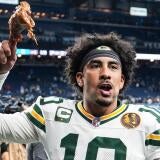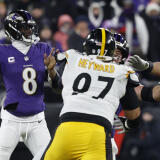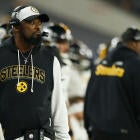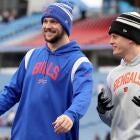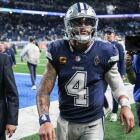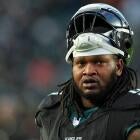After Further Review: Why Kirk Cousins is playing like a franchise QB
Kirk Cousins has teased, tantalized and tortured Redskins fans since being picked in 2012. And now he finally looks the part of a franchise quarterback. Film study reveals the biggest improvement in his game.

There are a lot of reasons for the improved play of Washington Redskins quarterback Kirk Cousins, who just might be playing himself into a mega-deal as the team's franchise passer.
But the one that stands out is improved accuracy.
A lot of quarterback coaches and quarterbacks say that accuracy is the most underrated part of being a quality quarterback. For Cousins, it has been markedly improved and the biggest reason he's on a torrid pace under center.
Cousins has 26 touchdown passes and 11 interceptions, but he has 20 touchdown passes and three interceptions in the past nine games. He has been carving up defenses as the Redskins have won the NFC East and earned a playoff spot.

In addition to accuracy, there are other factors at play for the improved Cousins.
Among them:
The return of receiver DeSean Jackson from injury and the emergence of tight end Jordan Reed as a go-to weapon who can play anywhere. “That Washington offense will be tough to stop in the playoffs because that tight end can run and you can't double him and Jackson,” one NFC personnel man said this week. “Jackson's speed has changed the dynamic of the offense.” Cousins is clearly more comfortable with Jackson on the field.
The line play is better. They have improved as a group in pass protection, and Cousins appears much more comfortable staying in the pocket. The Redskins still use a lot of bootleg concepts, but Cousins now will stand in and go through his progressions with a lot more confidence than at other times in his career.
That all helps, but it wouldn't mean much if Cousins didn't grow and play better individually than he did earlier this season and in his first three years in the league.
Since coming into the league as a fourth-round pick in 2012, drafted by the Redskins three rounds behind Robert Griffin III, Cousins has had moments where he's teased, tantalized and tortured Redskins fans. He's looked like a passer who could bring back a first-round pick in a trade -- which some speculated when RG3 got off to a great start as a rookie -- and then has looked like a career backup at best.
Coming into this season, Cousins had nine starts and had 18 touchdown passes and 19 interceptions. Mistakes were a major issue in those first three seasons. Accuracy was an issue, but so was his slower ability to process the defense and make his reads.
When he was named the team's starter in the summer, a move that surprised some because it meant RG3 and his big contract were heading to the bench, Cousins followed the same path the first six weeks. He threw six touchdown passes and eight interceptions in Washington's first six games as the Redskins went 2-4.
In studying those games, Cousins had issues with accuracy and decision-making. He wasn't as precise in his reads. There wasn't the same comfort level that there is now. In those six games, he had a passer rating over 100 only once. In the past nine, he has been over 100 seven times, with four over 120.0. That's impressive.
In those six games, his yards-per-attempt average was over 7.0 once. He has been over that number seven of the past nine games with four at 9.5 yards per-attempt or higher. That says he's being more accurate and he's also driving the football down the field. It helps that Jackson, the field stretcher, has played in the last seven games. Jackson's been over 20.0 per catch in four of those games.
Let's start with the difference in accuracy since it's so important Even when he completed passes earlier in the season, Cousins was leaving yards on the field with off-target throws.
Here's a look at one of those plays from the Week 3.

Cousins did a great job of being patient in the pocket to let receiver Andre Roberts cross the field. That's a plus.

But the negative came because his throw was off target. If Cousins puts the ball in front of Roberts, where it should have been, this would have likely been a huge play. It's still a good gain, but it could have been so much more.

That's where accuracy is so big for quarterbacks. It's the yards left on the field.
Here's another example where he missed what should have been a touchdown against the Eagles the following week. This one looks to be a mechanical issue as he bootlegged to his left.
Reed clearly beat the coverage and was wide open to the pylon. But Cousins did a terrible job of setting to throw.

You don't always set the feet to throw on a boot, but this was one where he had plenty of time to gather himself and drive the ball. Instead, he looked to make some sort of jump pass to get the ball to Reed.

It was well overthrown.
Contrast those accuracy issues with this throw from the second Eagles game in Week 16. He had Pierre Garcon locked up in with corner Eric Rowe in man coverage playing a trail technique.

Rowe did a nice job in coverage, but Cousins opted to try and make the throw anyway.

There wasn't a lot of room, but he took a chance. This is something he didn't do earlier in the season. He would wait until windows opened before taking his shots.

This window was small, but he took the shot anyway and put the ball right on the money. That's what great passers need to do to take their games to the next level.

They have to be willing to fit it into tight windows. Cousins is doing a better job of that.
Where he's really improving is with his decision making. Offensive coordinator Sean McVay and quarterbacks coach Matt Cavanaugh have done a great job of helping him with his pre-snap looks. It helps that Cousins is a work junkie, a film-room buff who color-codes his entire week in 15-minute increments on a paper to help plan it.
That's really anal, but that's the type of precision that helps make quarterbacks who they are in terms of preparation. It's clear that he puts the work in, but there's an even better picture now that he seeing things more clearly.
Here's a play from the Week 15 Bills game that shows that.
- Play: First-and-10 at the Buffalo 18 with 8:52 left in the second quarter
- Offense: (2WR, 2TE, 1RB) Shotgun, offset back
- Defense: Nickel, four-man rush, quarters coverage

The Redskins motioned Garcon before the snap and he ran a hard, inside-clearing route that forced safety Corey Graham to move to his left. Cousins helped move him with his eyes. That opened up a cavity behind nickel defender Nickell Robey.

When Reed faked an out, Leodis McKelvin widened and there was a lot of room for Cousins to make a nice, easy throw.

This was clearly a result of a pre-snap read that helped make this throw possible. When Robey failed to sink, and McKelvin widened, it was pitch-and-catch for six.

Here's another example of his allowing plays to unfold with his patience and his decision-making. This one also came from the Bills game.

This was a third-and-16 play where Buffalo rushed just three guys. Cousins had all day in the pocket, which allowed him to be patient. This throw took time.

He had to wait for Jamison Crowder to clear the zone before Garcon was able to come in behind on the deep in for an 18-yard gain and a first down.

While Cousins doesn't have a big arm, he showed on this play that he could get the ball to his receiver in a crowd quick enough. I also liked the ball placement on this throw.
It isn't all good for Cousins. There are times where he passes up shots down the field to take the check-down, although that's becoming less and less if it's there. He also can stay on his first read too long at times.
That happened on a sack against the Eagles. He waited too long to get off his first read and ended up getting dumped for a loss.
Cousins wanted to go to Jackson on a skinny post. The throw to Jackson would have been there, but he waited too long to see if he was clear. Take a look.

That enabled Fletcher Cox to dump him.

What he should have done was come off Jackson and hit Reed wide open in the middle of the field or dumped it down to Pierre Thomas in the left flat for a solid gain.
Those are the little things that will come for Cousins. The clock in his head isn't as good as it will be as he continues to play. Remember, this is just his first season as a starter.
The Cousins I saw the first three years and the fix six games of this season is not a passer who would be a candidate to be the franchise quarterback of the Redskins. The quarterback we've seen the past nine games has been that and more.
The next challenge will be the playoffs, where all quarterbacks are defined. The good ones show themselves to be that. The pretenders get eaten alive.
If Cousins can win a home playoff game in the wild-card round, he will cement himself as the quarterback of the future. I think the Redskins are leaning that way anyway, but it would be a definite then.
Who saw that coming? I sure didn't.
But by becoming a more accurate passer, Cousins has improved in every area. His numbers have gone up immensely since then. His timing is better. His confidence is evident.
Maybe he knew something when he uttered those now-famous words: “You like that!”
He certainly has been a different quarterback since then -- most importantly, an accurate one.
More observations from watching tape this week
The weekly Watt review: J.J. Watt got a sack. That used to be no big deal, but after going three games without one -- playing with a club protecting his broken right hand -- Watt got one last week against the Titans.
Since Watt is the best defensive player in the league, he gets a special section here every week. I watch every snap he plays. Some might think his play has tailed off, and maybe it has a tad because of the injury, but he's still a dominant player.
Watt's sack came early in the fourth quarter of his team's blowout of the Titans. He was in a one-on-one situation with right tackle Jamon Meredith. At the snap, Watt exploded out of his stance, and when Meredith went to put his hands on him Watt did a great job of using his hands to prevent that from happening. Once he didn't allow Meredith to use his hands, it was over. He went around him, crashed into Zach Mettenberger and knocked the ball loose. The Texans recovered.

Watt had just the one sack, but he also had six to seven plays where he was getting pressure. He also drew a hold on Byron Bell on one play.
In the run game, Watt was as active as he normally is in games. He made one really nice play for a 1-yard loss when he beat Taylor Lewan with a quick inside move. Lewan was flopped over to the right side in an unbalanced look, but Watt abused him on that play.
The Titans, like a lot of teams recently, used the tight end a few times to wham-block Watt as he charged up the field. That opens up an area for the back to slip through. Watt is so aggressive that this has become a counter move used more and more by teams.
The Texans continued to move him around in this game, from the down-left spot to the down-right and then stood him up again some inside. I also liked that they continue to have plays where they line up Watt and Jadeveon Clowney together on the same side.
As the Texans move into the playoffs, I think we will see more and more of that.
Hal turning heads in Texans' secondary: I talk a lot in this space about the young Texans defenders improving every week. Players like rookie linebacker Benardrick McKinney and rookie corner Kevin Johnson. But second-year safety Andre Hal is also playing well for the Texans as they head to the playoffs.
Hal is a former corner who moved inside to safety -- a trend that will grow by the year in the NFL -- and he's impressed the past few weeks. He has the range that you want on the back end with so many teams spreading defenses out.
Hal took over as the starter when Rahim Moore was benched in November and he has continued to grow as a player. Moore, who signed a three-year, $12-million free agent contract last spring, was a healthy scratch last week at Tennessee.
With Hal, Quintin Demps and Eddie Pleasant all playing well at safety, Moore is likely out after the season. Hal is the reason why.






